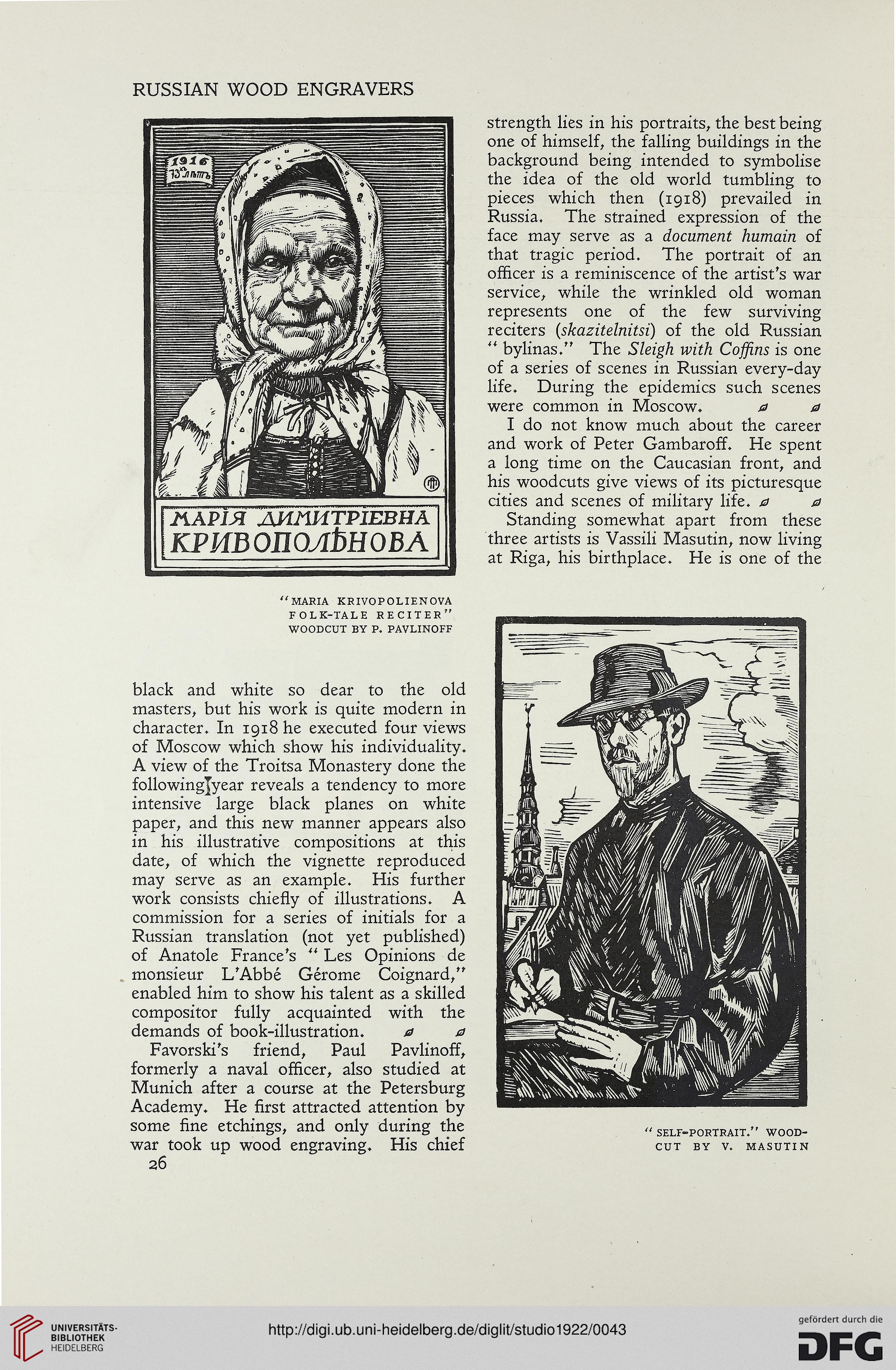RUSSIAN WOOD ENGRAVERS
rtAPIJl AHniiTPIEBHA
KPMBOnOAbHOBA
strength lies in his portraits, the best being
one of himself, the falling buildings in the
background being intended to symbolise
the idea of the old world tumbling to
pieces which then (1918) prevailed in
Russia. The strained expression of the
face may serve as a document humain of
that tragic period. The portrait of an
officer is a reminiscence of the artist's war
service, while the wrinkled old woman
represents one of the few surviving
reciters (skazitelnitsi) of the old Russian
u bylinas." The Sleigh with Coffins is one
of a series of scenes in Russian every-day
life. During the epidemics such scenes
were common in Moscow. 0 0
I do not know much about the career
and work of Peter Gambaroff. He spent
a long time on the Caucasian front, and
his woodcuts give views of its picturesque
cities and scenes of military life, 0 0
Standing somewhat apart from these
three artists is Vassili Masutin, now living
at Riga, his birthplace. He is one of the
"MARIA krivopolienova
FOLK-TALE RECITER”
WOODCUT BY P. PAVLINOFF
black and white so dear to the old
masters, but his work is quite modern in
character. In 1918 he executed four views
of Moscow which show his individuality.
A view of the Troitsa Monastery done the
followingjyear reveals a tendency to more
intensive large black planes on white
paper, and this new manner appears also
in his illustrative compositions at this
date, of which the vignette reproduced
may serve as an example. His further
work consists chiefly of illustrations. A
commission for a series of initials for a
Russian translation (not yet published)
of Anatole France's “ Les Opinions de
monsieur L'Abbe Gerome Coignard,"
enabled him to show his talent as a skilled
compositor fully acquainted with the
demands of book-illustration. 0 0
Favorski's friend, Paul Pavlinoff,
formerly a naval officer, also studied at
Munich after a course at the Petersburg
Academy. He first attracted attention by
some fine etchings, and only during the
war took up wood engraving. His chief
26
“ SELF-PORTRAIT.” WOOD-
CUT BY V. MASUTIN
rtAPIJl AHniiTPIEBHA
KPMBOnOAbHOBA
strength lies in his portraits, the best being
one of himself, the falling buildings in the
background being intended to symbolise
the idea of the old world tumbling to
pieces which then (1918) prevailed in
Russia. The strained expression of the
face may serve as a document humain of
that tragic period. The portrait of an
officer is a reminiscence of the artist's war
service, while the wrinkled old woman
represents one of the few surviving
reciters (skazitelnitsi) of the old Russian
u bylinas." The Sleigh with Coffins is one
of a series of scenes in Russian every-day
life. During the epidemics such scenes
were common in Moscow. 0 0
I do not know much about the career
and work of Peter Gambaroff. He spent
a long time on the Caucasian front, and
his woodcuts give views of its picturesque
cities and scenes of military life, 0 0
Standing somewhat apart from these
three artists is Vassili Masutin, now living
at Riga, his birthplace. He is one of the
"MARIA krivopolienova
FOLK-TALE RECITER”
WOODCUT BY P. PAVLINOFF
black and white so dear to the old
masters, but his work is quite modern in
character. In 1918 he executed four views
of Moscow which show his individuality.
A view of the Troitsa Monastery done the
followingjyear reveals a tendency to more
intensive large black planes on white
paper, and this new manner appears also
in his illustrative compositions at this
date, of which the vignette reproduced
may serve as an example. His further
work consists chiefly of illustrations. A
commission for a series of initials for a
Russian translation (not yet published)
of Anatole France's “ Les Opinions de
monsieur L'Abbe Gerome Coignard,"
enabled him to show his talent as a skilled
compositor fully acquainted with the
demands of book-illustration. 0 0
Favorski's friend, Paul Pavlinoff,
formerly a naval officer, also studied at
Munich after a course at the Petersburg
Academy. He first attracted attention by
some fine etchings, and only during the
war took up wood engraving. His chief
26
“ SELF-PORTRAIT.” WOOD-
CUT BY V. MASUTIN




